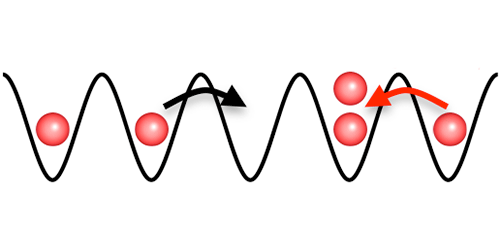No Vacancy for Tunneling
Cold atoms in an optical lattice are often used to simulate other systems, with the advantage that researchers can create a potential-energy landscape of their choosing. A new study has demonstrated a novel synthetic potential in which the tunneling between lattice sites depends on whether the destination site is occupied or vacant. Such occupation-dependent tunneling processes are believed to have crucial influence on complex materials such as superconductors and ferromagnets.
Recent work has shown that the tunneling rate for cold atoms can be controlled by periodically driving, or “shaking,” the optical lattice in which the atoms are arranged. Researchers have used this so-called Floquet engineering to simulate a wide range of phenomena, such as ferromagnetism and topological insulators.
Normally, shaken lattices modify the tunneling of a single atom, irrespective of the position of other atoms in the lattice. Hanns-Christoph Nägerl, from the University of Innsbruck in Austria, and his colleagues devised a system with occupation-dependent tunneling. The team placed bosonic cesium atoms in a three-dimensional optical lattice and applied a magnetic field to control the atom-atom interaction. Following a periodic modulation of this interaction, the team measured the distribution of atoms in the lattice, showing that the tunneling rate of atoms into occupied sites could be precisely tuned—and, moreover, set to zero—by varying the amplitude and duration of the modulation. Although not directly related to a specific material, this cold-atom system provides a test bed for investigating the possible role of occupation-dependent tunneling in complex materials.
This research is published in Physical Review Letters.
–Michael Schirber
Michael Schirber is a Corresponding Editor for Physics.





